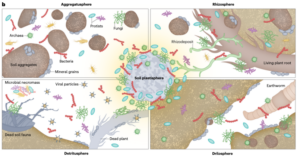
Acknowledgement: Acknowledges support from PAPILLONS (Plastics in Agricultural Production: Impacts, Lifecycles and Long-term sustainability, No. 101000210) of the European Union’s Horizon 2020 research and innovation programme.
Keywords: soil; plastisphere; microplastics; microbial;
Published in: Nature Reviews Microbiology (2023), 11 September 2023
https://doi.org/10.1038/s41579-023-00967-2
Please, find the full article here